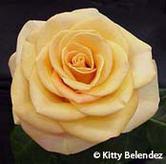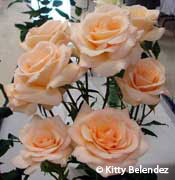EVALUATING YOUR ROSES
With the new year upon us, and the prospect of adding many new roses into our gardens this upcoming bare root season, most of uswill have to make some hard choices about which of our existing roses will need to find other places to reside.
I, like most other rose lovers that I know, have long since run out of lawn areas and the 'vanishing lawn syndrome' has now run its course so the roses that have not met my expectations need to go.
Making the Cesarean "thumbs up or down" during January has always been less effective than if I logically evaluate each rose during the growing season. I have found myself thinking --- '"Let's give it one more year -- MAYBE it will get better" or "Gosh, I hate to lose this one - it CAN be so pretty."
So here's the method I found tends to work better than all others I have tried. While it may be too late to get a good evaluation going for this season, consider getting a similar system going for next year.
Set up a point system. Each criteria will be given from 1 to 10 points plus give a numerical weight to each one as well. This factor will depend on what YOU determine is most important to YOU. Make a list of what you are expecting from a rose and answer some pertinent questions. Such as:
1. Fragrance. How important is it? Does the rose have a strong pleasing fragrance? Does it fill a room with a pleasant aroma? Would I grow this rose if it had no fragrance? 
2. Disease Resistance. Does this rose get powdery mildew? Rust? Black Spot? How unsightly is it? Does it make flowers unusable? Unshowable? 
3. Vase Life. How long does this rose last in a vase? Does it open too fast? Do the rose petals fall too quickly? 
4. Re-blooms fast. Does it come into bloom quickly? Does it take a long time to come back into bloom? Is it worth the wait? Is it a cropper? Blooms all at once and the nothing in between?
5. Vigor. Is this rose a weak grower? Spindly stems? Weak peduncles or necks? 
6. Pleasing color. Do I like the color of this rose? Is the color clear or muddy? 
7. Acceptable habit. Does the shape and size of the plant work in my garden? Is it too tall? Too wide? Is it a bush that grows like a climber? 
8. Attractive finish. Do the petals fall cleanly off the plant when the blossom has faded? Does the color fade or turn ugly? Does it burn? 
9. Exhibition potential. Will it show? Does it have good decorative or hybrid tea form? Do the petals quill? Do the flowers open too fast?
10. Pleasing bud and flower form. Do the rose buds have a pleasing color? Do they look burnt? Does the flower open evenly? Split centers? Not circular?
Your criteria may not be the same but try to make a fairly comprehensive list. Now, here's the hard part. Look at each item and give them a weight factor. Looking at the list above YOU might think that fragrance is the most important characteristic that you want in a rose. So you might give fragrance a multiplying factor of 5. So on your list, Double Delight might get 9 points then you would multiply that by 5 and get 45 points. Go on down your list and assign a multiplying factor to each category. My list looks like this.
1. Fragrance x 1
2. Disease resistance x 5
3. Vase Life x 3
4. Reblooms fast x 4
5. Vigorous x 3
6. Pleasing color x 2
7. Acceptable habit x 1
8. Attractive finish x 1
9. Exhibition potential x 2
10. Pleasing bud and flower form x 3
My perfect score would be a total of 250 points.
Next, you need to set up a point spread.
Mine looks like this.
175 -- 250 -- Definitely a keeper
125 -- 174 -- A keeper but might be lacking in several areas.
124 and below -- You're outta here!
Now for the really, really hard part! Evaluate your lovely roses objectively. This is the key. Be objective, be critical, and most of all be consistent. So get out a sheet of paper, stroll around your garden and start making your rose list. If you have a computer, so much the better. Make a spreadsheet and copy your data there and let the computer do all the work. Don't rely on just one evaluation -- recheck your numbers every week or so for several weeks.
Then, mark your low scoring roses with a red ribbon as you complete your evaluation. Then in January your difficult decisions are made and the non-performers go out -- just in time to plant your new hopefuls.
Here's some examples of my ranking for this year.
Marilyn Monroe HT Light amber
Fragrance = 3 points x 1 equals 3 points
Disease Resistance = 9 x 5 equals 45 points
Vase Life = 8 x 3 equals 24 points
Reblooms = 7 x 4 equals 28 points
Vigorous = 8 x 3 equals 24 points
Habit = 10 x 1 equals 10 points
Finish = 7 x 1 equals 7 points
Exhibition = 10 x 2 equals 20 points
Form = 10 x 3 equals 30 points
Total 201 -- A keeper
Buttercream HT Yellow
Fragrance = 1 x 1 equals 1 point
Disease Resistance = 8 x 5 equals 40 points
Vase Life = 5 x 3 equals 15 points
Reblooms = 2 x 4 equals 8 points
Vigorous = 3 x 3 equals 9 points
Habit = 8 x 1 equals 8 points
Finish = 6 x 1 equals 6 points
Exhibition = 6 x 2 equals 12 points
Form = 6 x 3 points equals 18 points
Total 127 -- Going - going - gone!
It's never too late to start your evaluations, so get outside with the roses so you can enjoy them while you score them.
© Copyright Chris Greenwood. All rights reserved.
Our Mailing Address
Pacific Rose Society
Post Office Box 1504
Sierra Madre, CA 91025
For questions about Pacific Rose Society, contact:
WEB DESIGNER: Kitty Belendez



